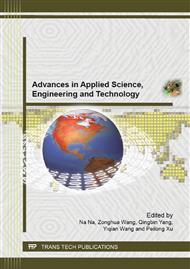[1]
Masatoshi Fujimura, Mineo Ideguchi, Yuji Minami, Keiichi Watanabe, and Kenjiro Tadera (2005). Amino Acid Sequence and Antimicrobial Activity of Chitin-Binding Peptides, Pp-AMP 1 and Pp-AMP 2, from Japanese Bamboo shoots (Phullostachys pubescens). Biotechnol, 69(3): 642-645.
DOI: 10.1271/bbb.69.642
Google Scholar
[2]
Du Ying, Qi Weiyan, Miao Xia, Li Guiying and Hu Changwei. (2004).Chemical Analysis of Pubescens and Its Pyrolysis. Journal of Chemical Industry and Engineering (China), 55(12), 2100-2104.
Google Scholar
[3]
Baiyi Lu, Daozhong Xia, Weisu Huang, Xiaoqin Wu, Ying Zhang, and Yiyuan Yao (2010). Hypolipidemic Effect of Bamboo Shoot Oil (P. pubescens) in Sprague-Dawley Rats. Journal Of Food Science, 75(6): H205-H211.
DOI: 10.1111/j.1750-3841.2010.01716.x
Google Scholar
[4]
Chung Minjay, Cheng Sensung, Lin Chunya (2012). Profiling of volatile compounds of Phyllostachys pubescens shoots in Taiwan. Food Chemistry, 134(4): 1732-1737.
DOI: 10.1016/j.foodchem.2012.03.120
Google Scholar
[5]
Kim Sang-Min, Jeon Je-Seung, Kang Suk-Woo, et. al (2011). Composition Analysis and Antioxidant Activity of Ojuk (Phyllostachys nigra Munro) Leaf Tea and Shoot Tea. Journal of Applied Biological Chemistry, 55(2): 95-101.
DOI: 10.3839/jabc.2011.065
Google Scholar
[6]
Martin , A. M. M, Sanuel, R. M, Israel, L. M (2008). Response surface methodology for optimisation of protein concentrate preparation from cowpea [ Vigna unguiculata (L.) Walp]. Food Chemistry, 110: 735-741.
DOI: 10.1016/j.foodchem.2008.02.040
Google Scholar
[7]
Makri, E., E. Papalamprou and G. Doxastakis. (2005). Study of functional properties of seed storage proteins from indigenous European legume crop (Lupin, pea, broad bean) in admixture with polysaccharides. Food Hydrocolloids, 19: 583-594.
DOI: 10.1016/j.foodhyd.2004.10.028
Google Scholar
[8]
Ali Abas Wani, Devinder Kaur, Idrees Ahmed, D. S. Sogi (2008). Extraction optimization of watermelon seed protein using response surface methodology. LWT-Food Science and Technology, 41:1514-1520.
DOI: 10.1016/j.lwt.2007.10.001
Google Scholar
[9]
Li Quanhong, Fu Caili (2005). Application of response surface methodology for extraction optimization of germinant pumpkin seeds protein. Food Chemistry, 92: 701-706.
DOI: 10.1016/j.foodchem.2004.08.042
Google Scholar
[10]
S. L. C. Ferreira, R. E. Bruns, H. S. Ferreira, G. D. Matos, et al. (2007). Box-Behnkendesign: An alternative for the optimization of analytical methods. Analytica Chimica Acta, 592(2): 179-186.
DOI: 10.1016/j.aca.2007.07.011
Google Scholar
[11]
Haber, A., & Runyon, R. (1977). General statistics (3rd ed.). Reading, MA: Addison-Wesley.
Google Scholar
[12]
Joglekar, A. M., & May, A. T. (1987). Product excellence through design of experiments. Cereal Foods World, 32, 857-868.
Google Scholar
[13]
Ebru Firatligil-Durmus, Ozgul Evranuz.(2010). Response surface methodology for protein extraction optimization of red pepper seed ( Capsicum frutescens ). LWT-Food Science and Technology, 43, 226-231.
DOI: 10.1016/j.lwt.2009.08.017
Google Scholar
[14]
Wang, H. X.,& Hu, C. Y. (2004). Study on the extraction and preliminary purification of tea protein. Science and Technology, 25, 69-73.
Google Scholar
[15]
Kadam, S. S., & Salunkhe, D. K. (1984). Winged bean in human nutrition. CRC Critical Reviews in Food Science and Nutrition, 21(1), 1-40.
DOI: 10.1080/10408398409527395
Google Scholar


